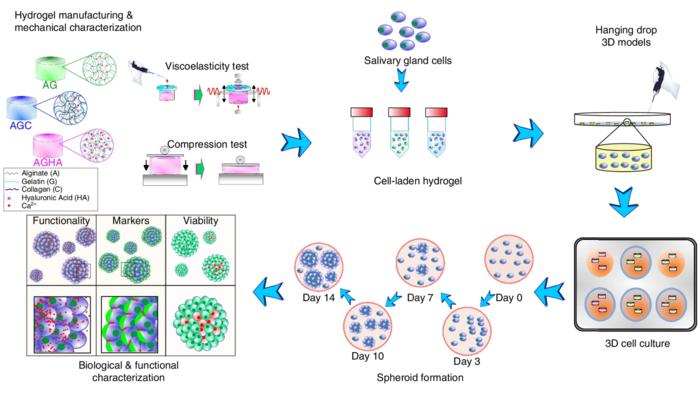Scientists have long sought to replicate the complex architecture and function of human salivary glands in the laboratory, driven by the urgent need to develop treatments for xerostomia, a chronic dry mouth condition that debilitates millions worldwide. This advanced tissue dysfunction results primarily from damage to the salivary gland caused by autoimmune diseases and radiation therapies used in cancer treatment. Until now, faithful in vitro models that support the growth, viability, and function of salivary acinar cells—the microscopic units responsible for saliva secretion—have remained elusive due to limitations in existing biomaterials and culture methods.
In a groundbreaking study published in the International Journal of Oral Science, a research team from McGill University has unveiled an innovative hydrogel platform that mimics the native microenvironment of human salivary glands. This next-generation hydrogel formulation, composed of an intricate blend of hyaluronic acid, alginate, and gelatin (AGHA), facilitates the three-dimensional (3D) culture of functional acinar cell spheroids. These spheroids retain cell viability, structural integrity, and essential secretory functions over extended culture periods, heralding a significant advancement in both tissue engineering and disease modeling.
Central to this breakthrough is the use of a thermo-ionically reversible hydrogel system, enabling the encapsulation of human salivary gland cells within a gel matrix that solidifies upon warming and ionic crosslinking. This dual crosslinking approach recreates the mechanical properties of native salivary tissue, providing cells with biocompatible support that fosters cell–matrix interactions crucial for survival and differentiation. Unlike traditional fixed or animal-derived scaffolds, this hydrogel formulation is fully synthetic, chemically defined, and allows for easy disassociation, essential for downstream applications and analysis.
The study systematically compared three hydrogel variants: a base alginate–gelatin scaffold (AG), a collagen-supplemented matrix (AGC), and the hyaluronic acid-enriched formulation (AGHA). All demonstrated mechanical characteristics akin to native gland tissue, but the AGHA gel distinctly excelled in promoting the formation of large, densely packed spheroids exceeding 100 cells with remarkable viability rates above 93%. This finding underscores the importance of hyaluronic acid, a key extracellular matrix component, in recapitulating the biochemical cues necessary for salivary acinar cell function.
Confocal microscopy and live/dead assays confirmed that spheroids grown within the AGHA hydrogel maintained structural cohesion and metabolic activity throughout 14 days of culture, a considerable achievement given the fragile nature of salivary acinar cells in vitro. Moreover, the 3D culture system preserved the expression of hallmark salivary proteins including aquaporin-5 (AQP5), tight junction protein ZO-1, the sodium-potassium-chloride cotransporter NKCC1, and digestive enzyme α-amylase. These proteins are critical for water transport, cellular polarization, and enzymatic secretion, collectively affirming the spheroids’ physiological relevance.
Perhaps most compelling is the functional responsiveness demonstrated by the spheroids upon stimulation with isoprenaline, a β-adrenergic agonist known to trigger salivary secretion in vivo. Treatment with this biochemical cue resulted in significant α-amylase granule exocytosis within spheroids, mimicking natural salivary gland activity. This confirms not only that the acinar cells retained their secretory capacity but also that the hydrogel system supports dynamic cellular signaling pathways critical for therapeutic and pharmacological investigations.
A notable advantage of the AGHA hydrogel lies in its thermosensitive and ionically reversible nature, which allows for the gentle retrieval of intact spheroids without enzymatic digestion or mechanical disruption. This reversible crosslinking is controlled through simple ion chelation, preserving delicate cell–cell and cell–matrix interactions. This feature dramatically expands the utility of the platform for clinical translation, enabling spheroid transplantation studies, high-throughput drug testing, and downstream molecular analyses with minimal cell damage.
Beyond spheroid formation, the AGHA platform demonstrated remarkable versatility by supporting the expansion of primary human salivary gland cells for up to 15 days. This extended culture capacity highlights its suitability for long-term studies of gland biology, disease modeling, and regenerative therapy development. In addition, the synthetic nature of the hydrogel eliminates batch variability and ethical concerns associated with animal-derived matrices, enhancing reproducibility and clinical relevance.
The implications of this technology are far-reaching. By faithfully mimicking the physical and biochemical salivary gland niche, the AGHA hydrogel provides a powerful new tool to study pathophysiological conditions such as Sjögren’s syndrome, radiation-induced gland damage, and other salivary dysfunctions at an unprecedented resolution. This platform also sets the stage for breakthroughs in personalized medicine, where patient-derived cells could be cultured to tailor treatments or evaluate drug responses in a controlled, physiologically relevant setting.
Dr. Simon D. Tran, senior author of the study, emphasized the strategic impact of this innovation: “Our development of the AGHA-based 3D culture platform bridges a critical gap in salivary gland research. It not only preserves acinar cell identity and function in vitro but also offers a non-destructive method for spheroid recovery, which is invaluable for regenerative strategies moving forward.” This statement highlights the system’s potential to accelerate the translation of salivary gland tissue engineering into clinical therapies targeting xerostomia and beyond.
In addition to its biological and clinical promise, the methodology employed epitomizes an elegant integration of polymer chemistry and cell biology. The careful tuning of hydrogel composition to balance mechanical stiffness, degradability, and biochemical functionality exemplifies a rational design approach that could be adapted to other organ systems. By incorporating biologically relevant polysaccharides like hyaluronic acid with synthetic components, researchers achieved an optimized microenvironment conducive to complex cell behavior.
In summary, the development of the thermo-ionically crosslinked AGHA hydrogel catalyzes a vital step toward restoring salivary gland function via tissue engineering. With its robust support of acinar spheroid formation, sustained functionality, and facile spheroid retrieval, this platform lays the foundation for next-generation in vitro models and regenerative therapies that could fundamentally transform treatment paradigms for patients suffering from debilitating xerostomia. The convergence of material science and cell biology embodied in this work opens new vistas for bioengineered tissue development, personalized medicine, and organ-on-chip technologies.
Subject of Research: Not applicable
Article Title: Expansion of functional human salivary acinar cell spheroids with reversible thermo-ionically crosslinked 3D hydrogels
News Publication Date: 9-May-2025
Web References:
https://www.nature.com/articles/s41368-025-00368-6
https://www.nature.com/ijos
References:
DOI: 10.1038/s41368-025-00368-6
Image Credits: International Journal of Oral Science
Keywords: Hydrogels




